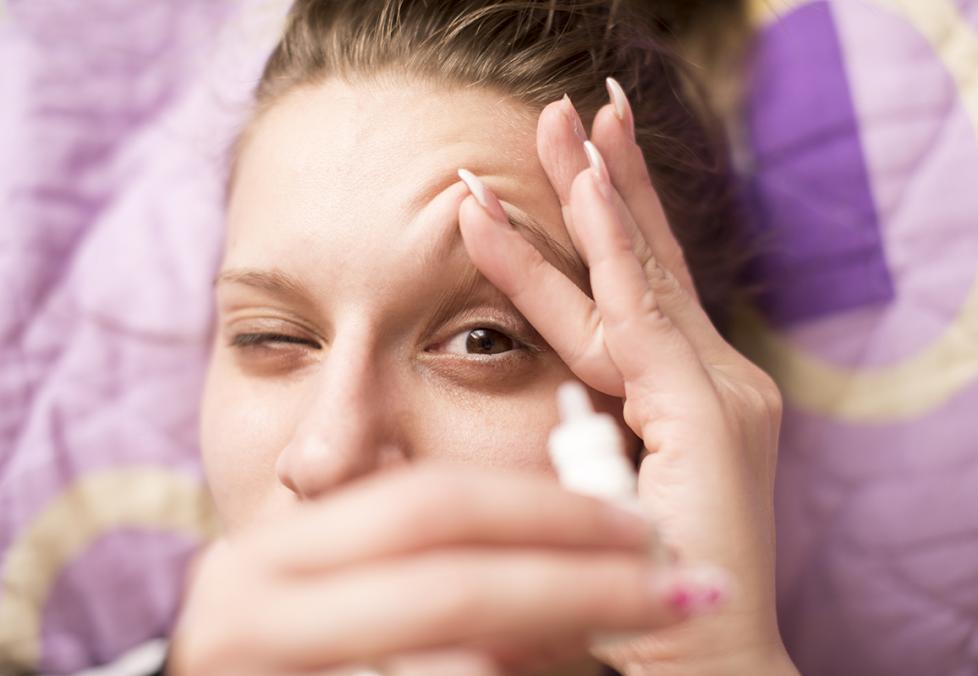
For healthy vision, healthy eyelids are key.

The poets say your eyes are the window to your soul. Maybe. But one thing’s for sure: Your eyelids are the gateway to your eyes.
They shield you from too much sun, guard against infection, and protect your cornea, the clear layer that covers your eye. Every time you blink, your eyelids work with your lashes to keep dirt out of your eye while spreading a protective layer of mucus, oil, and tears.
That’s a lot of work for lids, which are made up of the thinnest skin on your entire body.
So it’s no wonder that things can sometimes go wrong. To learn about eyelid issues — and what to do about them — we turned to Astiney Franklin, O.D. She’s an optometrist with America’s Best Contacts & Eyeglasses in Anderson, South Carolina.
Have questions about your eye health or vision? Your America’s Best optometrist is here to help! Click here to find an exam time that fits your schedule.
Eyelid Issue #1: Blepharitis
This condition is pretty common, Dr. Franklin says. “It’s an inflammation of the lids that can happen when your tear glands become blocked or clogged.”
Another cause: overgrowth of the normal bacteria that live on the skin around your eyes. Whatever the reason, you can end up with red, swollen, itchy eyelids and crusty flakes on your lashes.
Blepharitis can even play a part in another common eye condition known as dry eye. It’s more common in adults over age 40.
How it’s treated: “Blepharitis is uncomfortable but isn’t usually serious,” says Dr. Franklin. “With good hygiene, it sometimes goes away on its own.”
Her treatment tips:
- Medication. For severe inflammation, your eye doctor may prescribe an antibiotic, such as doxycycline.
- Warm compresses. Once or twice a day, dampen a clean cloth with warm water and place it over your eyes. Even after the condition clears up, continue the practice. “Be persistent,” Dr. Franklin advises. “You don’t have to do it every day — aim for a couple of times a week. It’s very important to get into the habit of good eye hygiene.”
- Eyedrops. Use over-the-counter drops to keep your eyes lubricated. But stay away from anti-redness eyedrops, which can cause more inflammation. Talk to your eye doctor or pharmacist about choosing the right drops.
- Sunglasses. Whenever you go outside, use sunglasses that have UVA and UVB protection.
Eyelid Issue #2: Ptosis
When your upper eyelid droops over your eye, that’s a classic sign of ptosis (pronounced toe-sis). Your lid can sag a little — or a lot, even covering your pupil, the black dot at the center of your eye that lets light in. That can limit your vision or even block it completely.
“Ptosis can be age-related,” Dr. Franklin explains. “Gravity weighs down every part of your body, and it can even start pulling your eyelid down over your eye. Or it could happen when bumps on your lids cause the skin to start sagging. It becomes serious when it gets in the way of your vision.”
How it’s treated: Treatments are meant to prevent vision loss, Dr. Franklin points out. But for some people, those droopy eyelids can also be a cosmetic problem.
Remedies include:
- Medication. A new prescription eyedrop called Upneeq® acts on the eyelid muscles, helping the lid open wider. Talk to your eye doctor to see if it’s right for you.
- Surgery. After receiving a local anesthetic to numb your eye and the area around it, the surgeon makes a small adjustment to your eyelid’s lifting muscle. If your ptosis is more severe, you may need to have the muscle strengthened and reattached to your eyelid. The procedure takes place in your doctor’s office, and you can go home the same day. “It’s a routine procedure, and the healing process is pretty quick,” says Dr. Franklin. “You won’t need to take much time off work.”
- Specialty contact lenses. Your eye doctor may want to insert a scleral contact lens, Dr. Franklin says. “It’s a really wide lens that can lift up the lid mechanically.”
Eyelid Issue #3: Blepharochalasis
This is an inflammatory condition that makes your eyelids swell. It doesn’t hurt, but once you get it, it can keep coming back a couple of times a year. It can make the skin of your eyelids thin and baggy — sometimes they’ll even hang down over your eye, affecting your vision.
How it’s treated: “Fortunately, it’s pretty rare,” says Dr. Franklin, “and though there’s no cure, there’s a surgical procedure that can treat it.”
- Blepharoplasty. “This is an outpatient surgery,” Dr. Franklin explains. “You’ll receive anesthesia, and the doctor will cut into your lid and remove the excess tissue that’s formed. You’ll notice that your eyelids will feel much less heavy.”

Eyelid Issue #4: Ectropion
This condition makes your eyelids turn outward, leaving the inside surface exposed and irritated. It mostly affects your lower lids, pulling them away from your eye and keeping tears from draining properly. That can leave your eyes feeling extra watery or dry, gritty, and sandy.
“It’s very common in older adults,” says Dr. Franklin. “When it happens, your eye isn’t closing fully. The bottom portion of your lid is flipped out, exposing your cornea to the air and the environment. That keeps your eyes from getting the moisture they need.”
You may notice sensitivity to light and dry eyes.
How it’s treated: There are a couple of temporary and more permanent remedies:
- Taping: Your eye doctor uses a special skin-safe tape to keep your eyes shut temporarily, says Dr. Franklin. “This can help keep your eyes moisturized when they’re super dry.”
- Eyedrops: Your eye doctor may prescribe drops to help lubricate your eyes.
- Surgery: An outpatient procedure, this involves tightening the eyelid and repositioning it so that it makes good contact with the eye.
Eyelid Issue #5: Entropion
Think of this condition as the opposite of ectropion. “Instead of turning outward, your eyelids turn inward toward your eye,” says Dr. Franklin.
It’s more likely to affect older adults, she says, and it’s often the result of typical aging changes in the eye. “It can be really uncomfortable,” Dr. Franklin points out. “It can cause scarring of your cornea when the lashes are inverted into your eyes.”
You can experience redness, tearing, and discharge from your eye.
How it’s treated: If you experience any of the symptoms of entropion, see your doctor. Left untreated, the condition can lead to eye infections and even vision loss.
- Eyedrops: Your doctor may prescribe eye ointments and artificial tears to moisturize your eyes and relieve discomfort.
- Soft contact lenses: These can act like a bandage to help protect your eyes from irritation.
- Tape or stitches: Your doctor may use a special skin-safe tape to temporarily reposition your eyelid. Or, using a local anesthesia, they may stitch your eye into a better position.
- Botox: An injection of this substance can weaken the muscles that make your eyelid turn inward. The procedure can be done every three or four months.
- Surgery: These are usually outpatient procedures done with a local anesthetic. One type of surgery tightens your eyelid. The other tightens the muscle that opens and closes your lid.

